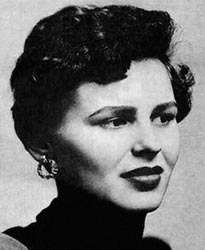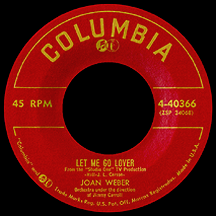JOAN WEBER
Let Me Go Lover
Songwriter and self-professed cowgirl Jenny Lou Carson had followed the career of Hank Williams to the end. His battle with the bottle and resultant death in January 1953 inspired her to write "Let Me Go, Devil," offering a no-punches-pulled wake-up call to anyone in a situation similar to Hank's. The song was released that summer by western swing singer Wade Ray. Other versions appeared by Tex Ritter (Carson had composed his number one C&W hit from 1945, "You Two-Timed Me One Time Too Often") and Johnny Bond. The song's serious tone was perhaps too bold for radio; none of the recordings were successful. In 1954, pop singer Georgie Shaw, coming off his first hit "Till We Two Are One," tackled the sensitive subject matter, releasing his take on "Let Me Go, Devil," but it also was not a hit.
Mitch Miller, on a winning streak as producer and A&R man at Columbia Records, had become aware of the song and felt it could be a big seller if the lyrics were tailored to fit a forlorn romantic situation. He gave songwriters Fred Wise, Ben Weisman and Kay Twomey the task of reworking Jenny Lou's lyrics. They came up with a new title, "Let Me Go Lover," and other than the 'Let me go' part it was a near-complete rewrite. Lines like 'First the gamblin', then the cheatin', then the bottles of rye...got the habit, had to have it, or die' were softened to 'You don't want me, but you want me to go on wanting you...now I pray that you will say that we're through.' The new version did retain some of the original's depressing tone: 'I've been a fool, yes a fool, just your tool, devil...a disgrace to the race of man' became 'You made me weep, cut me deep, I can't sleep, lover...I was cursed from the first day I fell.' Miller knew he would have to perform some promotional wizardry to prevent this version from going the way of the original.
New Jersey-born Joan Weber, fresh out of high school in 1954, had been auditioning around the New York area without catching a break. Already married and expecting a child (though her condition wasn't yet physically obvious), Joan made a demo recording of "Marionette," a pop tune that revealed an emotionally weepy vocal approach, a bit exaggerated when compared to the other popular singers of the day. Charles Randolph Grean, a producer and bandleader with RCA Victor, couldn't convince the label's executives to give her a shot, so he sent the demo to Miller, who signed her to the Columbia label. She recorded "Let Me Go Lover," backed by Jimmy Carroll and his orchestra, with songwriting credits going to Carson and the pseudoynm Al Hill in place of the trio of lyrics-revisers. It was released in November '54 with "Marionette" on the B side.

Mitch pulled some strings and suddenly Let Me Go Lover had become the title of an episode of Westinghouse Studio One, a long-running CBS anthology program. Broadcast on November 15, 1954, the teleplay concerned a disc jockey involved in a murder. Joan's recording of the song was featured six times during the episode in varying lengths ranging from excerpts to the entire song. Miller, anticipating demand for the unique recording, had arranged for thousands of 45s and 78s to be shipped to record stores across the country prior to the airing. Immediately, his hunch paid off...the record began selling like crazy the very next day. To further promote the single, Joan, recently turned 19 and noticeably pregnant, made appearances on television variety shows including Ed Sullivan's Toast of the Town in December.
Competitors scurried to get a piece of the action on this song that had become a sudden sensation. Teresa Brewer (who ultimately hit the top ten with her recording), Patti Page and Sunny Gale had versions out by year's end (each adding an exclamation point to the title!); Hank Snow jumped into the fray as well (changing the lyrics to 'Let me go, woman,' though the title on the record label remained unaltered), establishing the song as a country hit as it had originally been intended. Still, no one could catch the teenage girl with a tear in her voice; Joan Weber's "Let Me Go Lover" hit number one in January 1955, a million-selling mid-decade triumph.
Joan gave birth to her daughter while the record was cresting the charts. At the first opportunity, Miller got her back into the studio for a follow-up single, the Ivory Joe Hunter song "It May Sound Silly," a record survey no-show overshadowed by The McGuire Sisters' hit pop version and Hunter's R&B original. Momentum slipped away with successive efforts, varied in style and quality ("Lover-Lover," a misguided attempt at recapturing the magic of the first single, "Goodbye Lollipops, Hello Lipstick," a stab at the teen scene, and "Gone," a cover of Ferlin Husky's massive country and pop hit). By the time "Saturday Lover - Sunday Stranger" came out in the spring of 1957, it had become obvious a second hit wasn't in the cards. After Columbia dropped her, she performed whenever possible in clubs and at minor events before abandoning what was left of her show business career.
At some point it seemed as though Joan had vanished into thin air. No one at Columbia Records had a clue as to where she was. In 1969 the company mailed a royalty check to her last known residence, but it was returned stamped "address unknown." For years her whereabouts were a mystery until she turned up in a New Jersey mental facility sometime in the 1970s. In May 1981, while still institutionalized, Joan Weber died of heart failure. She was 45 years old.


